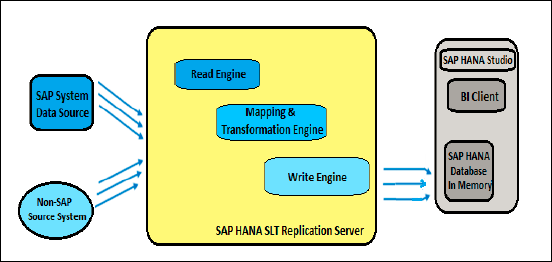
- SAP Simple Finance - Home
- SAP HANA - Introduction
- SAP Simple Finance - Introduction
- SAP Simple Finance - Architecture
- Extend G/L Coding Block
- Universal Journal
- Document Number
- Display Financial Tables
- Deployment Options
- Post & Reverse Documents
- Reporting Options
- SAP Simple Finance - Migration
- Manual Reposting of Costs
- SAP Simple Finance - G/L Accounting
- Create a Primary Cost
- Create a Secondary Cost
- SAP Simple Finance - Ledger Mgmt
- Asset Accounting
- Create an Asset
- SAP Simple Finance - Asset Scrapping
- Create Default Account Assignment
- Management Accounting
- Profitability Analysis
- Period Lock Transaction
- New Period Closing Program
- SAP Simple Finance - Integration
- SAP Simple Finance - IBPF
- Consultant Capabilities
SAP Simple Finance - Deployment Options
You can deploy a simple finance system either on-premise or in a cloud environment. When you deploy central finance system in cloud deployment scenario, the data replication is performed using the same mechanisms that is used in on-premise installations - SLT. To perform data replication via SLT, SLT portions will have to be available on both, the sending (on-premise) and the receiving system (cloud).
Non-SAP reporting and analytics, and additional SAP Simple Finance, or partner products need to be connected to the cloud instance or be made available within the cloud installation as required.

SLT Replication in HANA
SAP Landscape Transformation Replication is a trigger-based data replication method in HANA system. It is a perfect solution for replicating real-time data or schedule-based replication from SAP and non-SAP sources. It has SAP LT Replication server, which takes care of all trigger requests. Replication server can be installed as a standalone server or can run on any SAP system with SAP NW 7.02 or above.
There is a trusted RFC connection between HANA DB and ECC transaction system, which enables trigger-based data replication in HANA system environment.
Advantages of SLT Replication
Following are certain advantages of SLT Replication −
SLT Replication method allows data replication from multiple source systems to one HANA system, and also from one source system to multiple HANA systems.
SAP LT uses trigger-based approach. It has no measureable performance impact in the source system.
It also provides data transformation and filtering capability before loading to HANA database.
It allows real-time data replication, replicating only relevant data into HANA from SAP and non-SAP source systems.
It is fully integrated with HANA System and HANA studio.

Limitations of SLT Method
In SLT method, you dont have centrally executed processes that results in back-postings to the source systems in order to maintain the integrity and legacy system status of those systems.
The amount of configuration, customizing, and master data synchronization required in the central instance depends on the type of the process desired. Many scenarios, especially core GL scenarios, are achievable with a limited effort. More complex scenarios, or scenarios beyond (core GL) Finance might be challenging or in selected cases not feasible.